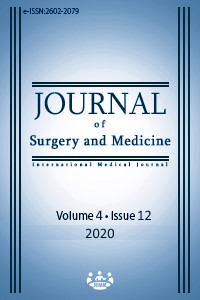Effects of creation of bladder flap during cesarean section on long-term residual urine volume and postoperative urinary retention
Keywords:
Bladder flap, Omission of a bladder flap, , Urinary retention, Cesarean sectionAbstract
Aim: Postpartum urinary retention (PUR) is an important clinical condition that is frequently detected after both vaginal and cesarean delivery. The aim of this study was to evaluate PUR in women who did and did not have bladder flaps created during cesarean section and the effect of Kegel exercises on long-term bladder muscle function in those with high postnatal residual urine volume. Methods: This prospective randomized study was conducted with 100 primiparous pregnant women who were to undergo elective cesarean section between April and December 2019. Patients were divided into two groups: The experimental group (bladder flap group, n=50) and the control group (non-bladder flap group, n=50). The study data were collected with the Maternal Information Form and UDI-6. Kegel exercise results, post-void residual volume and urinary system symptoms were assessed on the 2nd and 5th postoperative day and 6 weeks after birth. Results: There were no significant differences between the groups in terms of socio-demographic characteristics, postoperative 5th day and 6th week residual urine volume, postoperative urinary retention volume, urinary system symptoms (UDI-6 scores) and bladder injury. There were significant differences between the groups in terms of residual urine volume, duration of surgery, and pain values assessed on the second day (P=0.045, P<0.001, P<0.001, respectively). Intra group comparisons demonstrated a decrease in residual urine volume in the participants with high residual urine volume after Kegel exercises, and their postoperative 2nd day and 6th week residual urine volumes and UDI-6 scores were significantly different (P<0.001, P<0.001). Conclusion: The present study determined that bladder flaps created during cesarean section increases postoperative urinary retention. In patients with high residual urine volume, Kegel exercises reduce residual urine volumes and urinary symptoms in the long term.
Downloads
References
Boyle AL, Mulla BM, Lamb SV, Greer JA, Shippey SH, Rollene NL. Urinary symptoms after bladder flap at the time of primary cesarean delivery: a randomized controlled trial (RTC). International urogynecology journal. 2017;29(2):223-8.
Betrán AP, Ye J, Moller AB, Zhang J, Gülmezoglu AM, Torloni MR. The increasing trend in caesarean section rates: global, regional and national estimates: 1990-2014. PloS one. 2016;11(2):e0148343.
Malvasi A, Tinelli A, Gustapane S, Mazzone E, Cavallotti C, Stark M et al. Surgical technique to avoid bladder flap formation during cesarean section. G Chir. 2011;32(11-12):498-503.
Berghella V, Baxter JK, Chauhan SP. Evidence-based surgery for cesarean delivery. Am J Obstet Gynecol. 2005;193:1607–17.
Tuuli MG, Odibo AO, Fogerty P, Roehl K, Stamilio D, Macones GA. Utility of the bladder flap at cesarean delivery: a randomized controlled trial. Obstet Gynecol. 2012;119:815–21.
Dahlke JD, Mendez-Figueroa HM, Rouse DJ, Berghella V, Baxter JK, Chauhan SP. Evidence-based surgery for cesarean delivery: an updated systematic review. Am J Obstet Gynecol. 2013;209(4):294–306.
Liang CC, Chang SD, Chang YL, Chen SH, Chueh HY, Cheng PJ. Postpartum urinary retention after cesarean delivery. International Journal of Gynecology & Obstetrics. 2007;99(3):229-32.
Chai AT, Wong T, Mak HLJ, Cheon C, Yip SK, Wong ASM. Prevalence and associated risk factors of retention of urine after cesarean section. Int Urogynecol J. 2008;19:537–42.
Mulder FEM. Postpartum urinary retention: Risk factors, clinical impact and management. University of Amsterdam, Faculteit der Geneeskunde; 2017.
Bates CP, Bradley WE, Glen ES, Griffiths D, Melchior H, RowanD. Third Report on the Standardization of Terminology of Lower Urinary Tract Function Procedures related to the evaluation of micturition: pressure-flow relationships. Residual urine. Produced by the International Continence Society, February 1977. Br J Urol. 1980;52:348–50.
Yip SK, Sahota D, Pang MW, Chang A. Post- partum urinary retention. Acta Obstet Gynecol Scand. 2004;83:881–91.
Thanagumtorn K. Accuracy of Post-Void Residual Urine Volume Measurement Using an Ultrasound Bladder Scanner among Postoperative Radical Hysterectomy Patients. J Med Assoc Thai. 2016;99(10):1061-6.
Vassalo BJ, Kleeman SD, Segal LJ, et al. Tension free vaginal tape: A QOL assessment. Obstet Gynecol. 2002;100:518-24.
Cam C, Sakalli M, Ay P, Cam M, Karateke A. Validation of the short forms of the incontinence impact questionnaire (IIQ-7) and the urogenital distress inventory (UDI-6) in a Turkish population. Neurourology and Urodynamics. Official Journal of the International Continence Society. 2007;26(1):129-33.
Aslan FE Öntürk KZ. Ağrı ölçümü ve değerlendirilmesi. Aslan Eti, F. (Ed). Ağrı Doğası ve Kontrolü. Ankara. Akademisyen Tıp kitapevleri. 2014: 67-100.
George D, Mallery M. SPSS for Windows Step by Step: A Simple Guide and Reference, 17.0 update (10a ed.) Boston: Pearson (2010).
Mahajan NN: Justifying formation of bladder flap at Cesarean section? Arch Gynecol Obstet. 2009;279:853–5.
Cetin BA, Mathyk BA, Barut S, Zindar Y, Seckin KD, Kadirogullari P. Omission of a Bladder Flap during Cesarean Birth in Primiparous Women. Gynecologic and obstetric investigation. 2018;83(6):564-8.
Hohlagschwandtner M, Ruecklinger E, Husslein P, Joura EA. Is the formation of a bladder flap at cesarean necessary? A randomized trial. Obstetrics & Gynecology. 2001;98(6):1089-92.
O’Neill HA, Egan G, Walsh CA, Cotter AM, Walsh SR. Omission of the bladder flap at caesarean section reduces delivery time without increased morbidity: a meta-analysis of randomised controlled trials. European Journal of Obstetrics & Gynecology and Reproductive Biology. 2014;174:20-6.
Farideh Akhlaghi MD, Azadeh Khazaie MD, Fateme Jafaripour MS. Comparing Formation or Non-Formation of Bladder Flap at Cesarean Section on Perioperative and Postoperative Complications: Double-Blind Clinical Trial. J Family Reprod Health. 2017;11(3):152–8.
Kermans G, Wyndaele JJ, Thiery M, De Sy W: Puerperal urinary retention. Acta Urologica Belgica. 1986;54:376–85.
Yip SK, Sahota D, Pang MW, Chang A: Post-partum urinary retention. Acta Obstet Gynecol Scand. 2004;83:881–91.
Sumiasih NN, Sri Erawati NLP, Dwi Purnamayanti NM. The Effectivity of kegel Exercise to prevent the occurence of urınary retention and edema on the sutures of the perineum. The Journal of Health. 2012;9:167-72.
Downloads
- 607 841
Published
Issue
Section
How to Cite
License
Copyright (c) 2020 Derya Kanza Gül, Ayça Şolt
This work is licensed under a Creative Commons Attribution-NonCommercial-NoDerivatives 4.0 International License.
















